DECEMBER 2014
Bronze John Jay Finds a Home at His Namesake College
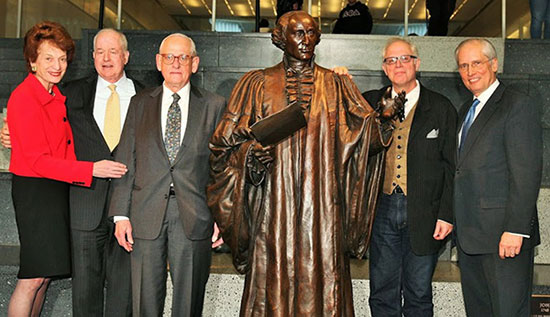
Li’l Jay, the ubiquitous John Jay bobblehead, now has a 5-foot-10-inch, 670-pound big brother!
On Dec. 8, President Jeremy Travis led a festive unveiling and dedication of the eagerly awaited full-size statue of John Jay, who was the first Chief Justice of the United States, among many other pivotal roles he played as one of the nation’s Founding Fathers.
The statue, a gleaming bronze created by StudioEIS in Brooklyn, stands in a position of spotlighted prominence in the Kroll Atrium, where it is accompanied by descriptive information on many of the highlights of Jay’s singular career as a patriot, jurist, elected official, diplomat and essayist.
“You can’t help but be impressed” by what Jay accomplished, President Travis noted, calling him “our forgotten Founding Father, one of the greatest New Yorkers, who helped create our democracy.” The statue, he said, provides “a way for us to reconnect with an important part of our nation’s history.”
Travis was followed to the lectern by John Jay College Foundation Chairman Jules Kroll, who read a proclamation from New York Mayor Bill DeBlasio declaring Dec. 8 as “John Jay College of Criminal Justice Day.” The proclamation notes: “As an engine for justice and innovation, John Jay College plays a critical role in our city’s evolution. May it continue to soar.”
Pierre Jay DeVeigh, one of many Jay descendants on hand for the ceremony, spoke for the family, congratulating the College community and singling out John Jay’s skills as negotiator — skills he said are badly needed today. “My hope is that in this time when the country is so divided, that someone from the John Jay College community will develop similar negotiating skills to help put this country back together again,” DeVeigh said.
Ivan Schwartz, one of the co-founders of StudioEIS, detailed the yearlong process of creating the likeness, speaking of his team’s “forensic pursuit of evidence” that included examining portraits and busts of Jay, measuring his only surviving judicial robe, and having a model photographed in different poses at the installation site to provide different alternative approaches to the eventual statue.
“We had to be meticulous about what John Jay looked like,” said Schwartz, whose studio has also created statues of such historical figures as Abraham Lincoln, Theodore Roosevelt, Frederick Douglass, and all 42 signers of the Constitution.
“Our job is less about making art than it is about activating the past,” said Schwartz. “This is our cultural raison d’être.”
The creative team included production manager Bj Ervick, head sculptor Jiwoong Cheh, portrait sculptor Stuart Williamson, and Schwartz’s partners in StudioEIS, his brother Elliot and sister Debra. The statue itself was cast by a foundry in Phoenix, Ariz.
“Our studio has been going for 40 years, and I believe we’re just now doing our best work,” Schwartz said. The spontaneous chorus of oohs and ahhs that erupted in the atrium when the statue was unveiled appeared to confirm Schwartz’s assessment.
For more photos of the dedication, click here.
Click here for coverage of the event in The New York Times.
Click here to read the Mayor’s proclamation.
Rising to the Challenge of Creating “the Modern John Jay”
President Offers Annual State-of-the-College Address
In an annual address that thoughtfully reflected on John Jay’s 50 years as “a unique and powerful institution. . .that has made an enormous difference in the world,” President Jeremy Travis offered his vision of the road ahead in his State of the College presentation on Nov. 12.
Citing the “bold vision” that led to the College’s creation in 1964, Travis noted that “the vision has always been larger than policing and larger than criminal justice.” That vision — still John Jay’s “guiding star,” the President said — “was to create an institution dedicated to ‘educating for justice.’”
The impact and contributions of John Jay over the past 50 years can be seen in the accomplishments of the more than 54,000 alumni and the scholarship of the faculty, said Travis, who went on to cite a “breathtaking” but partial list of such achievements. “The founders of John Jay must have known that creating an intellectual hub of activity on the issues of justice would have impact far beyond the four walls of the College,” he said. “But I doubt they imagined that John Jay would become such a vibrant institution with a global reach.”
The past decade has been a period of “remarkable transformation” for the College, Travis observed, with such developments as John Jay becoming a senior college in CUNY; the creation of the CUNY Justice Academy; the development of new liberal arts majors and a new General Education curriculum; admission into CUNY’s Macaulay Honors College, and most recently, the launch of John Jay Online and an Office of International Programs. As important, student satisfaction continues to rank highest in CUNY across a wide range of categories. “We provide a first-rate environment for our students, and they know it,” Travis said.
Nonetheless, he continued, challenges both new and ongoing confront the College, many related to the goal of promoting student success. Retention and graduation rates, while showing recent signs of improvement, remain “deeply troubling,” the President noted. “We will have to create a community-wide commitment to do what it takes to help our students succeed,” said Travis. “We will need to embrace the goal of ‘Finish in Four.’”
Designing and implementing a program to double the four-year graduation rate, said Travis, “will take a sustained effort calling on the best in all of us.”
After singing the praises of units that focus on life after John Jay — including the Pre Law Institute, the Office of Fellowship and Scholarship Opportunities and the Center for Career and Professional Development — Travis looked ahead to the creation of the College’s next five-year strategic plan, called John Jay 2020. An Ad Hoc Committee for the Strategic Plan is currently paring down a list of 10 goals for possible inclusion in the plan, with a “robust campus conversation” expected over the next several months in an effort to finalize the plan.
“The overarching opportunity facing us is to create the modern John Jay College,” Travis said, although he was quick to point out that the College is “sailing in uncertain financial waters.” Changes in the College’s business model are necessary, he noted, with the CUNY Compact about to expire and competition increasing among colleges and universities for the best high school students.
“John Jay has always risen to the challenges of the day,” the President concluded, “and we expect nothing less now. Much hangs in the balance. Our history reminds us that this institution is a force for good in the world. We know that prior generations have realized the promise of John Jay. Now it is our turn.”
First-Year Students, First-Rate Researchers
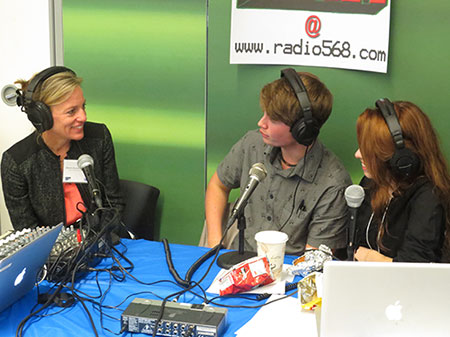
Interim Dean of Undergraduate Studies Allison Pease (l.) is interviewed by freshmen Thomas Faulkner and Sophia Canfield for a radio568.com podcast during the annual FYE Showcase.
Scores of John Jay freshmen and transfer students stood proudly alongside poster presentations in the new building cafeteria on Dec. 9, showing off their research projects as part of the annual FYE (First Year Experience) Student Showcase.
“It really is amazing that first-year students are doing such original research,” said Kate Szur, Senior Director of Student Academic Success Programs. Entering freshmen at John Jay, who can choose from dozens of Learning Communities or First-Year Seminars, presented their research at the showcase. Transfer students also had a prominent place in the showcase, as did students from the Adelante! program and the summer Early Start program.
Once again, the FYE Showcase also included a number of students from the CUNY Justice Academy program. One such student, Cristian Manuel, a second-year student at Borough of Manhattan Community College, was part of a team that assessed residents’ perceptions of safety in four New York City neighborhoods — Morris Heights and the Upper East Side in Manhattan, Maspeth, Queens, and Crown Heights, Brooklyn. “It was ethnographic research,” he explained confidently. “We had to do quantitative and qualitative interviews.”
Manuel is sold on the Justice Academy. “I love the program,” he said. “It’s everything I wanted, and I can’t wait to transfer to John Jay and continue my education.”
Beginning with the fall 2013 semester, the First-Year Seminar is part of John Jay’s new General Education curriculum. The students in each Learning Community are taught by two professors from different disciplines. In many cases, students work together on research and presentations in teams of two, three or more, either by design or at the suggestion of their professors.
The presentations — 120 poster displays and 72 digital or multimedia presentations — ran a gamut from housing segregation to police practices, from sex work to health and nutrition among college students. Belmin Nuredin and Allen Caro stood next to their poster presentation exploring media treatments of police stop-and-frisk practices, for a Criminal Justice 101 class taught by Professors Amanda Freeman and Daniel DiPrenda. “We were asked to choose a topic that touched on social justice,” Nuredin explained. “After researching, we found it’s the media that tends to show stop-and-frisk in a bad light.”
Set up at a table along one wall were students from Professor Alan Winson’s Self, Media and Society (English 131) class, who have created radio podcasts and live broadcasts on www.radio568.com. Throughout the showcase event, they interviewed college officials, faculty, fellow students and others with professionalism and flair. Most of the students have little or no radio-related skills prior to taking the class, Winson noted.
Two students, Sophia Canfield and Christian Yacca, co-wrote a murder mystery radio play that was performed live on Radio568. Thomas Faulkner, who deftly handled interviewing duties during the showcase, admitted that his first semester as a college student has been a bit of a shock. “I expected hard work,” he said, “but not this hard.”
Student-produced programs are archived on the class’s website.
Faculty, Students & Alumni Shine at ASC Conference
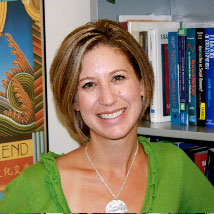
Professor Deborah Koetzle, Executive Officer of the Ph.D. program in Criminal Justice.
Over the four days of the conference, John Jay participants addressed a broad range of cutting-edge topics, including hate crimes and extremist groups, sex offenders, domestic violence, school shootings, piracy, and sentencing, imprisonment and prisoner reentry.
In addition to panel presentations, the John Jay contribution to the conference included President Jeremy Travis’s presidential plenary on “Causes and Consequences of Incarceration Growth in the United States”; a “Students-Meet-Scholars (Meet the Editors)” session with Professor Michael Maxfield, editor of the Journal of Research in Crime and Delinquency; and three “Author Meets Critics” sessions: Professor Ric Curtis on his book Foreigners Forever — Dignity and Exclusions among Second-Generation Muslim Drug Dealers; Professor Rosemary Barberet on Women, Crime and Criminal Justice; and Professor David Brotherton on Realist Criminology.
The John Jay participants included 39 students in the John Jay/CUNY Graduate Center doctoral programs in criminal justice and forensic psychology — a source of no small pride for Associate Professor Deborah Koetzle, Executive Officer of the PhD program in criminal justice.
“As always, the Criminal Justice PhD program sent a large complement of students to ASC,” she observed. “We’re very proud of our students. Several of my colleagues from around the country commented on the diversity of our students’ research interests and the quality of their presentations.”
There were also at least 10 doctoral program alumni on hand, said Koetzle.
On the closing night of the conference, Friday, Nov. 21, John Jay’s Office for the Advancement of Research hosted its annual ASC reception for alumni, members of the Criminal Justice Doctoral Students Association and conference participants. The event was co-sponsored by the Office of Alumni Relations as part of its ongoing “John Jay on the Road” series.
Future Scientist Is on a Fast Track to Success
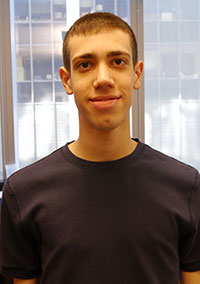 James Parziale is an unassuming upper senior who only began to cultivate his interest in science — and learning in general — as a high school student. Now, this late-bloomer is one of the bright lights of John Jay’s Forensic Science program, having recently completed a summer internship with the National Multiple Sclerosis Society (NMSS), during which he got a chance to do hands-on stem cell research.
James Parziale is an unassuming upper senior who only began to cultivate his interest in science — and learning in general — as a high school student. Now, this late-bloomer is one of the bright lights of John Jay’s Forensic Science program, having recently completed a summer internship with the National Multiple Sclerosis Society (NMSS), during which he got a chance to do hands-on stem cell research.
Parziale, a Brooklyn native and graduate of Midwood High School, has been excelling as a participant in the College’s Program for Research Initiatives for Science Majors (PRISM). There, under the mentorship of Professor Nathan Lents, he has produced research that is profound beyond the ability of most casual observers to decipher.
His latest PRISM research bears the hefty title of “Determination of the All-Trans Retinoic Acid Signaling Pathway in the Activation of RAR and RXR Receptors Leading to Expression in MZF-1 and the Relationship between CTGF, NOV and Platelets.” In a nutshell, Parziale’s research examines the impact of Vitamin A on gene transcription factors related to two proteins involved in cell proliferation, blood clotting and wound healing. “We know Vitamin A has a positive impact, but we don’t know why; we don’t know the mechanism by which it works,” he said.
If his experiments are successful, Parziale noted, “the possibility of utilizing Vitamin A before a medical procedure such as blood donation or bone marrow transplant may allow for the patient to recover much more rapidly, saving time and money for the healthcare system.”
Parziale chose John Jay because it was close to home and its affordability meant “I’ll graduate with no loans.” Forensic science had always appealed to him, he said, adding, “The way science was portrayed at John Jay made me think.” At John Jay, the PRISM program was a logical next step for the budding young researcher, and that led, in turn, to his coveted summer internship.
Working on a team with the principal investigator and a post-doctoral fellow, he recalled, “I started off with ‘Stem Cell 101,’ learning how to culture stem cells.”
“Never once did I think that I’d be doing stem cell research,” he said, “especially since it’s so controversial.”
At the end of the internship, he was chosen by his research team to do one of the presentations at the annual NMSS research symposium in September. “Research has helped me be a better presenter, even though I’m never fully comfortable with it,” said Parziale.
After the shy young scientist receives his B.S. degree next June, he plans to take a year off and then apply to medical school — ideally, a combined M.D./Ph.D. program. “I like research more than dealing with people,” he said.
Collaboration and Commercialization:
Grant Promotes Student Entrepreneurship
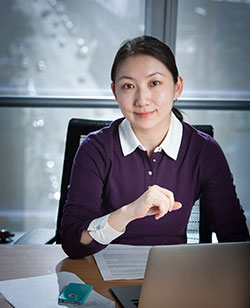 Professor Ping Ji of the Department of Mathematics and Computer Science is the recent recipient of a unique award from the National Science Foundation, an I-Corps Team Grant, which builds on her previous research in a way that promotes potential commercialization while offering a springboard into entrepreneurship for her graduate students.
Professor Ping Ji of the Department of Mathematics and Computer Science is the recent recipient of a unique award from the National Science Foundation, an I-Corps Team Grant, which builds on her previous research in a way that promotes potential commercialization while offering a springboard into entrepreneurship for her graduate students.
Ji, who is also Deputy Executive Officer of the Ph.D. program in Computer Science at the CUNY Graduate Center, has been developing an innovative monitoring and tracking system for locating mobile devices. The I-Corps grant is intended specifically to explore whether or not such technology can form the basis of a viable start-up business. And, although the research team is a collaborative effort among Ji, doctoral student Jie Chu and an industry mentor, it is Chu who serves as the entrepreneurial lead, responsible for laying the groundwork for a successful business.
With its emphasis on commercialization, the I-Corps grant presents new territory for Ji. “This grant entailed seven weeks of workshops,” she notes. “It’s really business training, much of which is focused on learning how to discover potential customers. Since our product is primarily applicable within law enforcement, our customer discovery involved surveying a number of people in that industry. On the whole, they thought this technology could be very useful.”
Conventional methods used to locate mobile devices depend on collaboration with the device itself and thus can be circumvented by malicious users. The technology Ji is creating makes it possible to locate mobile devices without such interaction, and can provide an obvious boon to law enforcement in tracking down devices involved in criminal activities. Ji also sees potential applications in health care, retail and network performance management systems.
I-Corps and similar grants can be a key to a healthy innovation loop connecting faculty and student researchers, the government and the economy, Ji observed. “I hope that more faculty and students will get involved in this kind of research effort,” she said. “Research should ultimately be useful; it should ‘go out of the building,’ as they say in the I-Corps workshops. This type of funding is important because it also recognizes the potential for students to be entrepreneurial and do impactful research that can be applied to improve people’s lives.”

Happy Holidays!
On Dec. 12, the College brought an afternoon of Christmas cheer to hundreds of less fortunate children and their families, with the arrival of the 33rd annual Jack Brennan Children’s Holiday Party. The John Jay gymnasium was transformed into a giant party space, as staff, student and faculty volunteers swung into action to serve an estimated 600 youngsters, many of them from shelters run by the New York City Department of Homeless Services. The party was created in 1982 by friends and colleagues of the late Jack Brennan, who wanted to honor the memory of the beloved former John Jay security director. Brennan was a devoted family man with a soft spot for children, and the holiday party seemed a fitting way to remember him.

How Sweep It Is!
Returning alumni who filled the Skybox in the gymnasium, along with hundreds of fans in the main-level bleachers, got a special Homecoming treat on Dec. 9, as the women’s and men’s basketball teams swept a doubleheader against City College. In the opening game, the women’s team led most of the way to pick up its first win of the season, 70-65. The men’s game was decided at the final buzzer by a dramatic three-point shot by senior Darell Robinson, sending head coach Ryan Hyland, the Bloodhound players and the crowd into a frenzy of celebration. The festivities also included raffles, merchandise giveaways, vintage athletic-gear sales and a halftime salute to student-athletes who are graduating seniors.

Men & Women of Honor
On Nov. 13, as part of a daylong Salute to Our Veterans celebration, U.S. Secretary of Veterans Affairs Robert McDonald (center, with green tie) visited John Jay to meet with student veterans and learn about their experiences and their transition to civilian life. After the visit, the New York State Industries for the Disabled Inc. dedicated the Veterans Resource Center at John Jay as a NYSID Battle Buddy Center in collaboration with the City University and Fedcap Rehabilitation Services. On hand for the Secretary’s visit were President Travis and John Jay College Foundation Trustee Peter Beshar.
